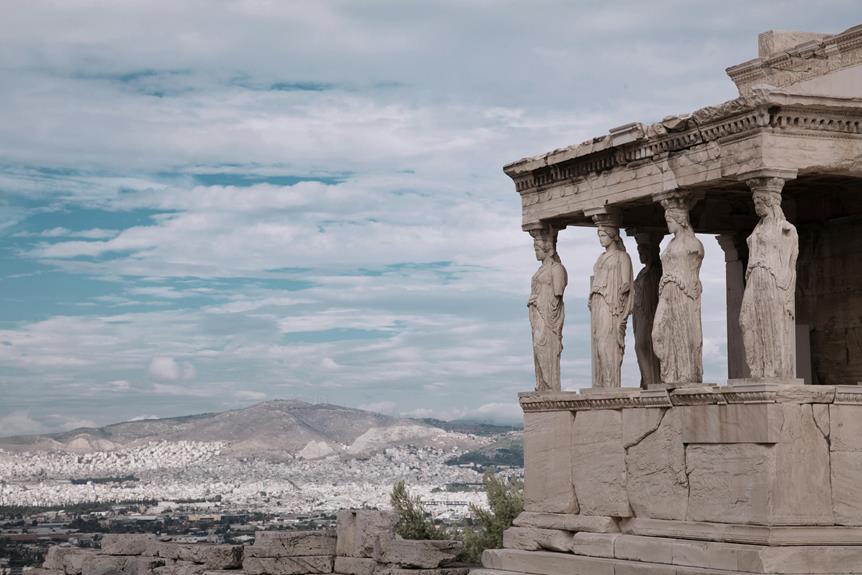Nestled in the coastal tranquility of Thailand, the Indian Ocean Tsunami Memorial stands as a solemn reminder of the catastrophic events of 2004. Its architectural significance and symbolic design elements create a contemplative atmosphere that transcends time and space, inviting visitors to reflect on the profound impact of natural disasters. As one explores the memorial's intricate details and pays homage to the lives lost, a deeper narrative unfolds, weaving together resilience, remembrance, and the enduring spirit of humanity. A visit to this memorial is not just a journey through history but a profound experience that resonates with the soul, leaving a lasting impression that transcends mere observation.
Key Takeaways
- Commemorates the 2004 Indian Ocean tsunami tragedy.
- Blends innovative design with cultural influences.
- Features symbolic elements like a wave and a reflecting pool.
- Offers reflective experiences and educational programs.
- Fosters community resilience and unity through shared experiences.
Historical Significance
The historical significance of Thailand's Indian Ocean Tsunami Memorial lies in its solemn commemoration of the devastating 2004 tsunami that struck the region. This tragic event, occurring on December 26, 2004, resulted from a massive undersea earthquake with a magnitude of 9.1-9.3 off the coast of Sumatra, Indonesia. The tsunami waves that followed wreaked havoc across multiple countries bordering the Indian Ocean, including Thailand, causing widespread destruction and claiming the lives of over 230,000 people.
Within this historical context, the Indian Ocean Tsunami Memorial in Thailand serves as a poignant reminder of the immense loss and suffering experienced by the Thai people and others affected by the disaster. The memorial stands as a symbol of remembrance for the lives lost, the communities devastated, and the resilience shown in the face of such a catastrophic event. It holds cultural importance as a place where visitors and locals alike can pay their respects, reflect on the tragedy, and honor the memories of those who perished.
Through its design and purpose, the memorial not only preserves the memory of the 2004 tsunami but also fosters a sense of unity, compassion, and solidarity among all those who visit, emphasizing the universal values of empathy and remembrance in the face of adversity.
Architectural Design
With a focus on the architectural design aspect of Thailand's Indian Ocean Tsunami Memorial, the structure's layout and aesthetics play a significant role in conveying the gravity of the 2004 tsunami tragedy. The memorial stands as a symbol of remembrance and resilience, blending innovative structures with deep cultural influences to honor the lives lost during the catastrophic event.
The architectural design of the memorial incorporates elements that evoke a sense of solemnity and reflection. The use of clean lines and simple forms creates a serene atmosphere, allowing visitors to contemplate the impact of the tsunami in a peaceful setting. The layout of the memorial is carefully planned to guide individuals through a journey of remembrance, with spaces for quiet contemplation and collective mourning.
Cultural influences are woven into the architectural design, reflecting Thailand's rich heritage and traditions. Ornate carvings and intricate detailing adorn the memorial, paying homage to the local craftsmanship and artistic expressions. The integration of cultural motifs not only enhances the visual appeal of the structure but also fosters a deeper connection to the land and its people.
Memorial Features
Incorporating a range of symbolic elements, the memorial features serve to deeply resonate with visitors and honor the memory of those affected by the 2004 Indian Ocean tsunami. The Indian Ocean Tsunami Memorial in Thailand is a poignant and emotional tribute to the lives lost during the devastating natural disaster.
One of the central features of the memorial is a wall with the names of the victims inscribed, providing a tangible connection to the individuals who perished. This symbolic representation guarantees that each person is remembered and honored, creating a sense of remembrance and respect.
Additionally, the memorial features a sculpture depicting a wave, symbolizing the powerful force of nature that caused immense destruction. The wave serves as a reminder of the overwhelming impact of the tsunami and the need for continued awareness and preparedness. Surrounding the sculpture are beautifully landscaped gardens, offering a serene space for contemplation and reflection.
Moreover, the inclusion of a reflecting pool within the memorial provides a tranquil setting for visitors to pay their respects. The pool symbolizes peace and healing, encouraging visitors to find solace and comfort in the midst of tragedy. Overall, the memorial features combine to create a moving and meaningful tribute to the victims of the 2004 Indian Ocean tsunami.
Visitor Experience
Located within the serene setting of the Indian Ocean Tsunami Memorial in Thailand, visitors can immerse themselves in a poignant and reflective experience that pays tribute to the lives lost in the 2004 disaster. The memorial offers a profound opportunity for emotional connections as visitors navigate through the various exhibits that honor the victims and the resilience of the affected communities.
The cultural significance of the memorial is palpable, with each element carefully curated to showcase the rich heritage of the region and the unity that emerged in the face of tragedy. Interactive exhibits provide visitors with a hands-on experience, allowing them to engage with the stories of survival and loss on a personal level. These exhibits not only educate but also inspire reflection and empathy.
Moreover, the memorial offers educational programs that explore further into the causes and effects of the tsunami, shedding light on the importance of disaster preparedness and community resilience. Through guided tours and informational displays, visitors gain a detailed understanding of the magnitude of the 2004 disaster and its lasting impact on the region.
Impact on Community
The aftermath of the 2004 Indian Ocean tsunami left a lasting impact on the communities surrounding the memorial in Thailand, shaping their resilience and response to future disasters. The community healing process has been an essential aspect of rebuilding the lives of those affected. Emotional support initiatives have played a key role in helping individuals cope with the trauma and loss experienced during the catastrophic event.
In the wake of the tsunami, the affected communities came together to support one another, fostering a sense of unity and solidarity. This collective strength has been instrumental in the healing process, allowing individuals to lean on each other for support and comfort. The memorial serves as a reminder of the resilience and spirit of the community in the face of adversity.
Various programs and services have been implemented to provide emotional support to those in need. Counseling services, support groups, and community activities have all played a part in helping individuals navigate the complex emotions that arise in the aftermath of a disaster. By creating a space for individuals to share their experiences and feelings, the community has been able to come together and heal collectively.
Remembering the Victims
To honor the memory of the victims of the 2004 Indian Ocean tsunami, the Thailand's Indian Ocean Tsunami Memorial stands as a solemn tribute to those who lost their lives in the devastating natural disaster. The memorial serves as a poignant reminder of the tragedy that struck the region, allowing visitors to pay their respects and reflect on the lives lost. For the victims' families, the memorial holds significant importance, providing a place where they can come to remember their loved ones and find solace in the midst of their grief.
In the healing process after such a catastrophic event, remembering the victims plays an essential role in the collective mourning and recovery of the community. The memorial offers a space for both locals and tourists to acknowledge the impact of the tsunami and to come together in remembrance. By honoring the victims and sharing in their memory, individuals can find comfort and support in each other, fostering a sense of unity and resilience.
As visitors walk through the memorial grounds, reading the names of the victims inscribed on the walls and witnessing the symbolic representations of loss and hope, they are reminded of the fragility of life and the strength of the human spirit. The act of remembering the victims not only honors their legacy but also serves as a reminder of the importance of coming together in times of tragedy to support one another.
Frequently Asked Questions
How Was the Funding for the Memorial Raised?
Fundraising efforts for the memorial were primarily driven by community support. Various initiatives, such as charity events, donation drives, and partnerships with local businesses, helped raise the necessary funds.
The community's strong commitment to honoring the victims of the tragedy played a significant role in ensuring the success of these fundraising endeavors.
Are There Any Upcoming Events or Ceremonies at the Memorial?
Upcoming events and ceremonies at the memorial are crucial for engaging the community and honoring the significance of the site. These gatherings provide opportunities for reflection, remembrance, and education.
Additionally, they contribute to the maintenance of the memorial by fostering a sense of connection and stewardship among visitors. Educational programs offered during these events can further enhance the understanding and appreciation of the memorial's historical and cultural importance.
Can Visitors Contribute to the Maintenance of the Memorial?
Donation opportunities and volunteer involvement play vital roles in the maintenance of memorials and public spaces. Visitors can often contribute to the upkeep of such sites through monetary donations, fundraising events, or by offering their time and skills through volunteer programs.
Are There Any Educational Programs or Initiatives Associated With the Memorial?
Without context, educational programs and community initiatives play a crucial role in promoting awareness and fostering a sense of responsibility. Such programs serve as catalysts for growth and development, providing individuals with opportunities to expand their knowledge and engage with their surroundings in meaningful ways.
Is There a Specific Message or Symbolism Behind the Memorial's Design?
The design of the memorial encapsulates a profound symbolic representation that serves to honor the lives lost and convey the resilience of the human spirit in the face of tragedy.
Its architectural significance lies in the careful integration of elements that evoke themes of remembrance, renewal, and unity.
The deliberate use of space, materials, and forms contributes to creating a poignant and contemplative atmosphere that invites visitors to reflect on the profound impact of the Indian Ocean Tsunami.
Conclusion
To wrap up, the Indian Ocean Tsunami Memorial in Thailand stands as a significant tribute to the tragic events of 2004.
Its architectural design and memorial features provide a somber yet educational experience for visitors, highlighting the importance of disaster preparedness and community resilience.
The memorial's impact on the community fosters unity and remembrance, serving as a timeless homage to the victims of the devastating tsunami.


